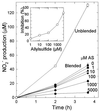Inhibition of nitrifiers and methanotrophs from an agricultural humisol by allylsulfide and its implications for environmental studies
- PMID: 10347027
- PMCID: PMC91362
- DOI: 10.1128/AEM.65.6.2461-2465.1999
Inhibition of nitrifiers and methanotrophs from an agricultural humisol by allylsulfide and its implications for environmental studies
Abstract
Allylsulfide, an inhibitor of ammonia monooxygenase, was tested to determine its ability to inhibit nitrification and methane oxidation in pure cultures, in agricultural humisol enrichment cultures, and in humisol slurries. We confirmed that allylsulfide is a differential inhibitor of cultures of nitrifiers and methanotrophs at concentrations of 1 and 200 microM, respectively, which result in 50% inhibition. However, although a nitrifying enrichment culture added to sterilized humisol was inhibited 50% by 4 microM allylsulfide, 500 microM allylsulfide was necessary for 50% inhibition of the endogenous nitrifying activity in nonsterile humisol. We concluded that native nitrifiers were protected, possibly by being in colonial aggregates or sheltered microenvironments.
Figures




Similar articles
-
Differential inhibition by allylsulfide of nitrification and methane oxidation in freshwater sediment.Appl Environ Microbiol. 1995 Dec;61(12):4278-83. doi: 10.1128/aem.61.12.4278-4283.1995. Appl Environ Microbiol. 1995. PMID: 16535183 Free PMC article.
-
Physiology, biochemistry, and specific inhibitors of CH4, NH4+, and CO oxidation by methanotrophs and nitrifiers.Microbiol Rev. 1989 Mar;53(1):68-84. doi: 10.1128/mr.53.1.68-84.1989. Microbiol Rev. 1989. PMID: 2496288 Free PMC article. Review.
-
Radioactive fingerprinting of microorganisms that oxidize atmospheric methane in different soils.Appl Environ Microbiol. 1999 Sep;65(9):4064-70. doi: 10.1128/AEM.65.9.4064-4070.1999. Appl Environ Microbiol. 1999. PMID: 10473417 Free PMC article.
-
Influence of pesticides on methane oxidation in a flooded tropical rice soil.Bull Environ Contam Toxicol. 1997 Aug;59(2):222-9. doi: 10.1007/s001289900468. Bull Environ Contam Toxicol. 1997. PMID: 9211692 No abstract available.
-
[Research progress of atmospheric methane oxidizers in soil].Wei Sheng Wu Xue Bao. 2014 Aug 4;54(8):841-53. Wei Sheng Wu Xue Bao. 2014. PMID: 25345015 Review. Chinese.
Cited by
-
Factors driving potential ammonia oxidation in Canadian arctic ecosystems: does spatial scale matter?Appl Environ Microbiol. 2012 Jan;78(2):346-53. doi: 10.1128/AEM.06132-11. Epub 2011 Nov 11. Appl Environ Microbiol. 2012. PMID: 22081570 Free PMC article.
-
A meta-analysis to examine whether nitrification inhibitors work through selectively inhibiting ammonia-oxidizing bacteria.Front Microbiol. 2022 Jul 19;13:962146. doi: 10.3389/fmicb.2022.962146. eCollection 2022. Front Microbiol. 2022. PMID: 35928162 Free PMC article.
-
The Antifungal Effect of Garlic Essential Oil on Phytophthora nicotianae and the Inhibitory Component Involved.Biomolecules. 2019 Oct 21;9(10):632. doi: 10.3390/biom9100632. Biomolecules. 2019. PMID: 31640228 Free PMC article.
References
-
- Bédard C, Knowles R. Some properties of methane oxidation in a thermally stratified lake. Can J Fish Aquat Sci. 1997;54:1639–1645.
-
- Chancy H F, Kamprath E J. Effect of nitrapyrin rate on nitrification in soils having different organic matter contents. Soil Sci. 1987;144:29–35.
-
- Dalton H. Ammonia oxidation by the methane-oxidizing bacterium Methylococcus capsulatus strain Bath. Arch Microbiol. 1977;114:273–279.
Publication types
MeSH terms
Substances
LinkOut - more resources
Full Text Sources

